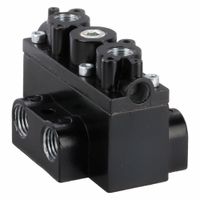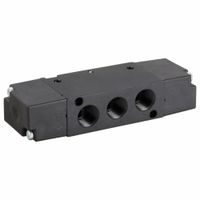Call +(254) 703 030 000 / 751 483 999 / 721 704 777
- Home
- Pneumatics
- Pneumatic Valves
- Inline Air Control Valves
- Pilot Operated Inline Air Control Valves
.....Read More
Frequently Asked Questions
What is a pilot-operated inline air control valve?
A pilot-operated inline air control valve is a type of valve used to control the flow of air in pneumatic systems. It operates using a pilot mechanism, which is a smaller, secondary valve that controls the main valve. This design allows the main valve to handle larger flow rates and pressures with minimal effort.
The pilot valve is typically actuated by a small amount of air pressure, which then opens or closes the main valve. This setup is advantageous because it allows for precise control of large volumes of air with relatively low energy input. The pilot valve can be controlled manually, electrically, or pneumatically, depending on the system's requirements.
In operation, when the pilot valve is activated, it changes the pressure in a chamber connected to the main valve. This pressure change causes the main valve to move, either opening or closing the flow path. The main valve can be a poppet, diaphragm, or spool type, depending on the specific application and design requirements.
Pilot-operated inline air control valves are commonly used in industrial applications where precise control of air flow is necessary, such as in automated machinery, process control systems, and pneumatic actuators. They offer advantages like reduced wear and tear on the main valve components, improved response times, and the ability to handle high flow rates and pressures efficiently.
Overall, these valves are essential components in pneumatic systems, providing reliable and efficient control of air flow with minimal energy consumption.
How does a pilot-operated valve control air pressure in a pneumatic system?
A pilot-operated valve controls air pressure in a pneumatic system by using a smaller pilot valve to actuate a larger main valve. This setup allows for precise control of high-pressure systems with minimal effort. The pilot valve, which requires less force to operate, directs air pressure to the actuator of the main valve. When the pilot valve is activated, it opens a pathway for air to flow into the actuator chamber of the main valve.
The increased pressure in the actuator chamber causes the main valve to open or close, depending on its design. This action allows the main valve to control the flow of air through the system, regulating pressure as needed. The pilot valve can be controlled manually, electrically, or pneumatically, providing flexibility in operation.
In a typical setup, the pilot valve is connected to a control signal, which can be a pressure switch, a solenoid, or a manual lever. When the control signal is activated, the pilot valve opens, allowing air to flow into the actuator chamber. This air pressure moves a diaphragm or piston, which in turn moves the main valve to its desired position.
The advantage of using a pilot-operated valve is that it allows for the control of large volumes of air with minimal input force. This is particularly useful in systems where high pressure or large flow rates are involved, as it reduces the need for large, cumbersome actuators. Additionally, pilot-operated valves provide faster response times and more accurate control compared to direct-acting valves, making them ideal for complex pneumatic systems.
What are the benefits of using pilot-operated valves over electrically actuated valves?
Pilot-operated valves offer several benefits over electrically actuated valves:
1. **Energy Efficiency**: Pilot-operated valves use the system's fluid pressure to open and close, requiring minimal external energy. In contrast, electrically actuated valves need continuous electrical power, which can be less efficient.
2. **Cost-Effectiveness**: They are generally less expensive to operate and maintain since they do not require electrical components or wiring, reducing installation and operational costs.
3. **Reliability and Durability**: With fewer moving parts and no electrical components, pilot-operated valves are less prone to failure and can operate reliably in harsh environments, including explosive or wet conditions where electrical components might fail.
4. **Pressure Handling**: These valves are well-suited for high-pressure applications as they can handle large pressure differentials without requiring large actuators, unlike electrically actuated valves which may need more robust and costly actuators for similar conditions.
5. **Fail-Safe Operation**: In the event of a power failure, pilot-operated valves can be designed to default to a safe position (open or closed) using the system pressure, whereas electrically actuated valves may require additional components like battery backups to achieve a fail-safe state.
6. **Simplicity and Maintenance**: The simpler design of pilot-operated valves makes them easier to maintain and repair, reducing downtime and maintenance costs.
7. **Temperature Tolerance**: They can operate effectively in extreme temperatures where electrical components might fail or require additional protection.
8. **Versatility**: Suitable for a wide range of applications, including those involving corrosive or hazardous fluids, without the risk of electrical hazards.
Overall, pilot-operated valves are advantageous in applications where energy efficiency, cost, reliability, and safety are critical considerations.
How do I choose the right pilot-operated valve for my system?
To choose the right pilot-operated valve for your system, consider the following factors:
1. **Application Requirements**: Determine the specific function the valve will perform, such as pressure regulation, flow control, or directional control.
2. **System Pressure and Flow**: Ensure the valve can handle the maximum pressure and flow rate of your system. Check the valve's pressure rating and flow coefficient (Cv) to match your system's specifications.
3. **Fluid Type**: Identify the type of fluid (e.g., gas, liquid, corrosive, or abrasive) and ensure the valve materials are compatible to prevent corrosion or wear.
4. **Temperature Range**: Verify that the valve can operate within the temperature range of your system. Consider the thermal expansion and contraction of materials.
5. **Size and Port Configuration**: Select the appropriate valve size and port configuration to fit your system's piping and connection requirements.
6. **Response Time**: Consider the required response time for the valve to open or close, especially in applications needing quick actuation.
7. **Control Method**: Decide between manual, pneumatic, hydraulic, or electric actuation based on your system's control needs and available power sources.
8. **Installation Environment**: Assess the installation environment for factors like space constraints, exposure to elements, and accessibility for maintenance.
9. **Reliability and Maintenance**: Choose a valve with a proven track record for reliability and ease of maintenance. Consider the availability of spare parts and technical support.
10. **Cost and Budget**: Balance the initial cost with long-term operational and maintenance costs. Opt for a valve that offers the best value for your budget.
11. **Compliance and Standards**: Ensure the valve meets industry standards and regulations relevant to your application, such as ASME, API, or ISO.
By evaluating these factors, you can select a pilot-operated valve that meets your system's needs effectively and efficiently.
What brands offer compatible pilot-operated inline air control valves?
Brands that offer compatible pilot-operated inline air control valves include:
1. **Festo**: Known for a wide range of pneumatic and automation solutions, Festo provides high-quality pilot-operated valves suitable for various industrial applications.
2. **SMC Corporation**: A leading manufacturer of pneumatic components, SMC offers a variety of pilot-operated valves that are compatible with different systems and applications.
3. **Parker Hannifin**: Parker's pneumatic division offers a comprehensive range of pilot-operated valves designed for reliability and efficiency in air control systems.
4. **Norgren (part of IMI Precision Engineering)**: Norgren provides robust and efficient pilot-operated valves that are compatible with numerous industrial applications.
5. **Bosch Rexroth**: Known for their precision engineering, Bosch Rexroth offers pilot-operated valves that are suitable for a wide range of pneumatic applications.
6. **ASCO (Emerson)**: ASCO provides a variety of pilot-operated valves that are designed for compatibility and reliability in industrial automation systems.
7. **Bürkert**: Specializing in fluid control systems, Bürkert offers pilot-operated valves that are compatible with various pneumatic applications.
8. **NORGREN**: Offers a range of pilot-operated valves known for their durability and compatibility with different pneumatic systems.
9. **Aventics (part of Emerson)**: Aventics provides a selection of pilot-operated valves that are designed for efficient air control in industrial applications.
10. **CKD Corporation**: CKD offers a variety of pilot-operated valves that are compatible with different pneumatic systems and applications.
These brands are recognized for their quality, reliability, and innovation in pneumatic technology, making them suitable choices for pilot-operated inline air control valves.
How do I install a pilot-operated inline air control valve?
1. **Select the Valve**: Choose a pilot-operated inline air control valve suitable for your system's pressure, flow rate, and application requirements.
2. **Gather Tools and Materials**: Ensure you have the necessary tools such as wrenches, pipe cutters, thread sealant or Teflon tape, and any mounting hardware.
3. **Safety Precautions**: Turn off the air supply and depressurize the system to prevent accidents.
4. **Identify Installation Location**: Determine the appropriate location in the air line where the valve will be installed, ensuring it is accessible for maintenance.
5. **Prepare the Piping**: Cut the air line at the chosen location using a pipe cutter. Ensure the cuts are clean and free of burrs.
6. **Install Fittings**: Attach the necessary fittings to the valve ports. Use thread sealant or Teflon tape on threaded connections to prevent leaks.
7. **Mount the Valve**: Position the valve in the air line, ensuring the flow direction matches the arrow on the valve body. Secure the valve using appropriate mounting hardware if required.
8. **Connect the Pilot Line**: Attach the pilot line to the valve's pilot port. Ensure the pilot line is properly sized and rated for the system pressure.
9. **Check Connections**: Tighten all connections securely, ensuring there are no leaks.
10. **Restore Air Supply**: Gradually turn on the air supply and pressurize the system.
11. **Test the Valve**: Operate the valve to ensure it functions correctly. Check for leaks and proper operation of the pilot mechanism.
12. **Final Inspection**: Conduct a final inspection to ensure all connections are secure and the valve operates as intended. Make any necessary adjustments.
What maintenance is required for pilot-operated inline air control valves?
Maintenance for pilot-operated inline air control valves involves several key steps to ensure optimal performance and longevity:
1. **Regular Inspection**: Conduct routine visual inspections to check for any signs of wear, corrosion, or damage. Look for leaks, unusual noises, or vibrations that may indicate underlying issues.
2. **Cleaning**: Keep the valve and surrounding area clean from dust, dirt, and debris. Use appropriate cleaning agents that do not damage the valve materials. Ensure that the pilot lines and ports are free from obstructions.
3. **Lubrication**: Apply suitable lubricants to moving parts as recommended by the manufacturer. This helps reduce friction and wear, ensuring smooth operation.
4. **Seal and Gasket Check**: Inspect seals and gaskets for wear or damage. Replace them if necessary to prevent leaks and maintain pressure integrity.
5. **Pilot System Maintenance**: Ensure that the pilot system, including the pilot valve and lines, is functioning correctly. Check for blockages or leaks in the pilot lines and ensure the pilot valve is operating smoothly.
6. **Pressure Testing**: Perform pressure tests to verify that the valve maintains the required pressure levels without leaks. This helps in identifying any potential issues with the valve's sealing capability.
7. **Calibration**: Regularly calibrate the valve to ensure it operates within the specified parameters. This may involve adjusting the pilot pressure or other settings as per the manufacturer's guidelines.
8. **Replacement of Worn Parts**: Replace any worn or damaged components promptly to prevent further damage and ensure reliable operation.
9. **Documentation**: Keep detailed records of all maintenance activities, including inspections, repairs, and replacements. This helps in tracking the valve's performance and planning future maintenance.
10. **Training**: Ensure that maintenance personnel are adequately trained and familiar with the specific valve model and its maintenance requirements.
By following these maintenance practices, the reliability and efficiency of pilot-operated inline air control valves can be significantly enhanced.


